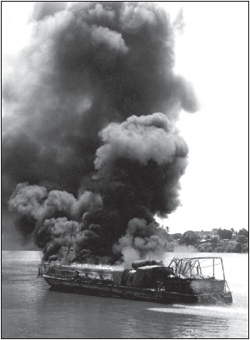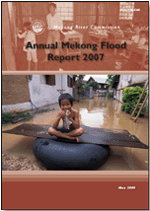Mekong News - Archive
April - June 2008
Issue 2008/2
In this issue:
- MRC Hydropower Programme gets under way
- Scenario work to reveal hydrological impacts
- New initiative to tackle climate change
- Basin changes will demand new solutions
- Navigation project to make Mekong safer
- World Water Day visions brighten up Secretariat
- MRC increases cooperation with China
- More water, bigger fish
- Simulation training tool provides hands-on experience of flood issues
- Council & JC Chairs rotate
- Regional centre works to reduce flood damage
- Information Products
- Upcoming events
MRC Hydropower Programme gets under way

The cumulative effects of existing
and new hydropower facilities on natural
resources will be analysed by a combination of MRC programmes.
Building on its 2001 Hydropower Strategy, and to address the challenge of helping regional plans for hydropower development evolve in ways that also benefi t local populations, the MRC has started its Hydropower Programme. The programme is looking to engage government agencies, private developers, fi nanciers and civil society groups in discussing the opportunities and risks associated with hydropower projects, beginning with a regional stakeholder consultation meeting in September 2008.
This consultation will bring together senior government offi cials from the MRC Member States and Dialogue Partners, the developers of existing and future hydropower projects, banks and international fi nancial institutions, environmental and social experts, NGOs, research groups and the media.
The aim is to elicit feedback on the scope and approach of the MRC Hydropower Programme and gather information that will help shape it into an effective initiative. The consultation will also provide a chance to assess and disseminate related fast-track activities of other MRC programmes.
The Hydropower Programme will take a two-track approach to its operations. Track 1 will include short-term activities focused on understanding the regional implications of, and opportunities for hydropower projects. Among these activities will be modelling work on dry season fl ows and sediments under the BDP, and Fisheries Programme research on fi sh migration and the cumulative barrier effects of dams.

Traditional hydrotechnology helps
this farmer
water his field - how can he also benefit from
mainstream hydroelectricity projects?
To build an overall picture of the impacts of basin-wide water resources development options, including hydropower developments on the mainstream and tributaries, the Environment Programme will provide assessment tools for sustainable environmental and social aspects, while the Navigation Programme is developing standard specifications for ship locks on dams. This first track is now underway and should be mostly completed by December 2008.
Track 2 will see the programme build on and share knowledge, expanding the MRC’s database on existing, planned and proposed hydropower projects and building capacity for environmental review through a proposed case study covering the mainstream of the Lower Mekong Basin. The programme will continue to facilitate dialogue at different levels on the key issues facing the hydropower sector and will launch a strategic environmental assessment of mainstream dam proposals. Track 2 activities will be initiated in September 2008.
The MRC, as a regional organisation, has an important part to play in improving understanding of the regional implications of hydropower projects, working with agencies responsible for hydropower development as well as developers and other stakeholders. The Commission’s partnerships across the four countries put it in a unique position to reach out to the full range of stakeholders.
Scenario work to reveal hydrological impacts
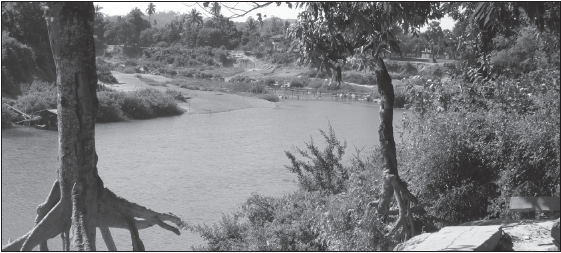
Sub-area teams will soon start preparing
comprehensive tributary basin profi les.
Development planning across the whole Lower Mekong Basin should become easier in the future thanks to the MRC’s new basin-wide scenario work. The fi rst results on the hydrological impacts of various likely scenarios will be available in September 2008 through the Basin Development Plan Programme.
Formulation of the scenarios, including a mainstream dam scenario, is progressing well and working groups in the member countries are creating databases containing all relevant data on hydropower and irrigation, including the priority ranking of planned projects and potential longer-term developments.
As a result of this process, government planning departments, line agencies and provinces in each country will be able to better judge the potential effects of various projects and so make well-informed decisions.
During the scenario-building work the MRC’s hydropower database is being considerably improved to contain the policy, regulatory technical and economic information needed for the emerging hydropower programme.
The Basin Development Programme has already held its first meeting with a newly- established regional and multi-sectoral working group on development scenarios and integrated water resource management strategy for the basin. The meeting discussed the first drafts of the process and methodology for the formulation and assessment of scenarios and individual projects. Following a second meeting, the BDP assessment framework (which includes the policy and other criteria that will be used for assessing scenarios and projects) will be reviewed by the MRC Joint Committee later this year.
Meanwhile, sub-area teams are being formed in each of the member countries to prepare comprehensive tributary basin profiles. This will be the first step in the preparation of sub-area strategies that will promote a better understanding of the potential and the constraints for water resources development and management in different parts of each sub-area.
This work will avoid conflicts between projects and allow the various sectors and provinces to include social and environmental considerations in their plans. The activities in each sub-area are being coordinated with many local, national and international agencies and NGOs.
New initiative to tackle climate change
Climate change could bring disaster
to people in the Mekong Basin.
The impact of climate change on the Mekong Basin, particularly in the Delta region, is becoming an issue of increasing concern and is expected to have significant impacts on water availability, agricultural production and fisheries. These three sectors provide the livelihood for the vast majority of rural villagers, the biggest and most vulnerable social group in the basin.
Under an agreement signed in April 2008, researchers from Australia’s Commonwealth Scientific and Industrial Research Organisation and the MRC will assess the potential impacts of climate change on the environment in the Lower Mekong Basin countries: Cambodia, the Lao PDR, Thailand and Viet Nam.
The agreement is one in a series of partnerships between the Government of Australia and the MRC to study climate change in the Mekong region.
These efforts will complement other ongoing initiatives to help the governments of the area develop strategies to adapt to new environmental conditions. The overall goal is to minimise the disadvantages that climate change will bring to the poorest people of the basin.
The MRC will work together with the Member States to use the results of this project to develop activities that can complement existing and future climate change projects conducted by other organisations and development partners.
One of these new projects, the Climate Change Adaptation Initiative, will run within the MRC’s own Environment Programme from 2008-2012, providing baseline data, planning tools, a policy framework, capacity building and monitoring. These will enable decisionmakers to prepare strategies to integrate climate change considerations into poverty reduction efforts.
The project, which started in March 2008, is now in its design phase and will involve intensive stakeholder consultation to define MRC climate change goals, objectives and priorities.
The combined efforts of the partners involved in this exercise will produce a roadmap outlining a work plan of activities needed to achieve objectives, expected outputs, a quality analysis system with a value effectiveness review, and safeguards incorporating progress monitoring.
When phase 1 is complete the project will go on to develop or adapt evaluation and predictive tools, design and conduct pilot projects, draw up policy frameworks for use by national agencies, build capacity in line agencies, and help integrate policies into local planning.
The MRC’s Watershed Management Project, run in conjunction with GTZ, has already been studying the effects of climate change on livelihoods and productivity of local people in watersheds.
The Commission is now in the process of formulating activities in two fields: enhancing the adaptive capacities of watershed management stakeholders and water user groups in its pilot projects; and developing innovative financial mechanisms to cope with climate change.
The Watershed Management project is currently designing activities that will enable watershed management stakeholders to benefit from these mechanisms, and these will be closely liked to the new Climate Change Adaptation Initiative.
For more information contact Dr Vithet Srinetr, MRC Environment Programme Coordinator: vithet@mrcmekong.org
Basin changes will demand new solutions
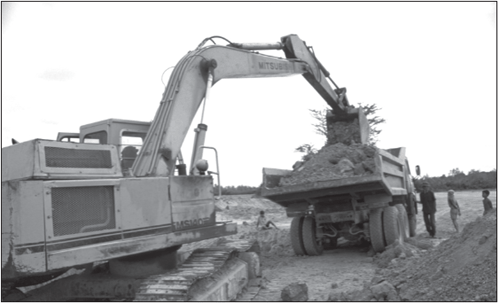
The change that comes with rapid growth
brings environmental and other risks.
The opportunities and risks that come with economic growth was a key issue discussed at the 27th meeting of the MRC Joint Committee in Danang, Viet Nam on 2-3 April 2008. The meeting also examined other issues central to development of the basin’s water resources.
Viet Nam’s Vice Minister for Agriculture and Rural Development, Dr Dao Xuan Hoc, described the current situation in the region as a period of exciting development in Southeast Asia, with the countries of the Mekong River Basin experiencing strong economic growth. However, he pointed out that with growth comes rapid change, which always carries some social and environmental risks.
Joint Committee Chairman Mr Nguyen Hong Toan acknowledged that, given the amount of activity involving basin water resources either already underway or being discussed at high levels, the MRC’s role was coming under scrutiny within the region. This attention was coming from environmental groups, civil society and non-governmental organisations, but also from the development partners that fund the MRC, from government agencies whose plans and projects will be affected by water developments, and from the general public.
Mr Toan asserted that the MRC must play a major role in ensuring that plans for using the resources of the Mekong and its tributaries are coordinated and backed by proper scientific research combined with socio-economic and environmental assessment.
The meeting heard discussed progress within the programmes and future plans. It was informed that the financial situation of the MRC was sound and Member Countries had shown an increased sense of ownership over the past year.
In other business Joint Committee delegates also approved the MRC Annual Report for 2007, reached agreement on the next steps for improving the monitoring and evaluation procedures of MRC programmes, and decided that the MRC Secretariat would, within the next three months, examine the framework for hosting a forum of stakeholders interested in discussing major development issues in the basin, including hydropower. The date for this forum has now been fixed for September
Navigation project to make Mekong safer
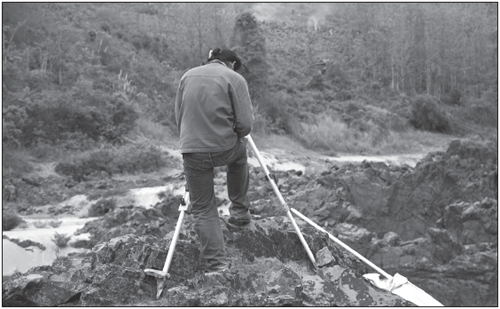
Detailed survey work is needed before
safety markers and aids can be installed in Laos
and Thailand.
Dangerous areas of the Mekong River in the Lao PDR and Thailand will eventually become safer for river pilots, passengers and traders once the MRC Navigation Programme is able to replicate work it has completed in the busy shipping lanes from Phnom Penh Port in Cambodia to the Viet Nam border.
The programme has commenced a topohydrographic survey of selected areas of danger as the first step in its project to install new aids to navigation on the Mekong River between Luang Prabang and Pakse in the Lao PDR. This project will be of benefit to both Laos and Thailand as they share the river in this area.
A topo-hydrographic survey team travelled along this section of the river in early 2008 to make preliminary investigations into water levels, river depths and flow patterns, and to identify natural obstacles.
Prior to installation of navigational aids several steps have to be completed. Phase 1 is a condition survey, which includes gathering of topo-hydrographic data and production of charts. This is followed by a waterway classification of the entire stretch and entails determination of the optimal ship size for use of the waterway. Then a channel design is made, using the information provided to decide which types of buoys to use and their best locations. The final phase is manufacturing and installation of these navigational aids.
Along the Mekong in the Lao PDR and Thailand are geological factors that restrict open-river navigation. These include spots with high turbulence, strong currents, decreased depth in low-water periods, and reduced navigability due to rock outcrops.

While not all reaches of the Mekong show the same potential for increased ship size or for better navigation, the Navigation Programme is dedicated to helping its member countries design a common river transport infrastructure that can make best use of the river’s natural potential. Through previous production of a Hydrographic Atlas, the MRC has acquired knowledge of river navigation channel locations and depths, making it possible to indicate the ‘natural’ navigation channel without the need for any physical channel improvement work.
The 426-km stretch between Luang Prabang and Vientiane is full of rocky outcrops that are particularly dangerous to navigation. Only skilled and experienced pilots can negotiate the swift currents and sharp bends of the channel meandering between the rocks. Between Vientiane and Pakse (715 km) draft is restricted during the low water period by shallow sandbars and rocky outcrops.
Installation of a reliable system of standardised aids to navigation, such as shore marks, buoys, beacons, leading lines and channel marks, will improve safety and reduce riverine accidents. A single bad accident involving dangerous cargo could have disastrous impacts on drinking water, aquatic habitation and irrigation throughout the entire Lower Mekong River.
This project will therefore be compatible with overall MRC aims of environmental protection: By improving shipping safety on the Mekong it will reduce the risk of groundings and collisions, and therefore decrease the chances of spillage pollution. Increased opportunity for river freight transport should also reduce the pollution caused by transporting goods overland. Coordinating agencies for the project are the Lao and Thai National Mekong Committees.
For more information contact Phirun Hiek at the MRC Navigation Programme: phirun@mrcmekong.org
World Water Day visions brighten up Secretariat
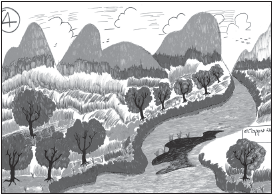
Picture by Saysana Khampanvong, aged
12.
The artistic perceptions of Lao secondary school students on issues affecting their watershed now adorn the main stairs of the MRC Secretariat in Vientiane.
Nine colourful pictures, created by pupils of Ban Phialat school in Sangthong district, Vientiane province, were chosen to open a revolving exhibition of Mekong-related artwork within the Secretariat. The pictures, drawn to mark this year’s World Water Day, were organised by the Watershed Management project co-managed by the MRC and GTZ. Sangthong district lies within the Nam Ton watershed, which has experienced substantial deforestation in recent years.
The frames in the Secretariat stairwell will be used to display a range of work over the next two years. Anyone wishing to display A3-sized artwork relating to the Mekong and its people, including photography, in the MRC headquarters should contact the Communications Unit through Aiden Glendinning (aiden@mrcmekong.org).
MRC increases cooperation with China
The condition survey of dangerous
areas and improvement for navigation on the Mekong
River between Houei Sai and Luang Prabang in now in progress.
Chinese navigation experts recently expressed a strong desire to work together with the MRC to ensure that plans for river transport and hydropower development along the Mekong River are made in consideration of each other.
In May 2008 MRC Navigation Programme representatives met with Yunnan province officials responsible for navigational affairs, waterway transport planning, and communications. One area of discussion was the condition survey of dangerous areas and improvement for navigation along a stretch of the Mekong in northern Laos.
The Chinese experts noted that navigation plans would have to consider planned hydropower cascades and said this would require a larger integrated master plan covering all resources and sectors. In the meantime, the MRC’s detailed channel marking of the dangerous stretches between Houai Sai and Luang Prabang will continue, as this is part of a major tourist route between Chiang Rai and Luang Prabang.
The project will reduce accidents and improve navigation safety without negatively affecting the environment.
Discussions were also held on the first Seminar on Waterway Safety and Navigation Improvement, to be held in Jinghong, Yunnan, from 14-16 October.
Improved navigation safety will reduce
the
potential for accidents and environmental
problems caused by spills.
This technical meeting of navigation professionals and relevant experts will build consensus on navigation development on the Lancang-Mekong as a basis for long-term planning.
The seminar will address physical aspects of navigation safety, in particular those related to navigation channel improvement.
Another topic will be the significance of the environment and ecology of the river within the framework of waterborne transport. Participants will work on an action plan to mitigate the environmental and social impacts of river regulating works, while promoting sound waterborne transport development and coordination.
Participants at the seminar will also discuss a study of new technologies and methods for associated development of hydropower and navigation.
Presentations will be made by navigation professionals from China and the MRC Member States, and by international experts on waterways, the environment, river engineering and navigation locks.
More water, bigger fish
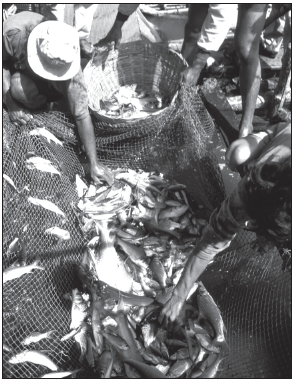
Extended floods appear to have a positive
effect on
fish landings in Cambodia. Picture: Joe Garrison
Results from studies in Cambodia show that longer and more extensive flooding results in bigger fish in rivers and wetlands.
Staff from the Cambodian Fisheries Administration and the MRC Fisheries Programme have been monitoring the Cambodian stationary trawl (or dai) fishery on the Tonle Sap River for 13 years and have recently been working on ways to relate the catch to the level of annual flooding.
This has resulted in a new flood index, which describes the extent and duration of flooding in the system for the entire flood season. Until now most measurements were related to the peak flood period, which is generally taken to be a 31-day period recorded 15 days each side of the maximum recorded water level at Phnom Penh Port.
Using the new flood index, the team looked at catches over the past ten years. It was discovered that more extensive floods resulted in larger fish size. In fact the average fish size varied by a factor of three to four times, depending on the size of the flood. These preliminary results suggest it is the increase in average fish size which is primarily responsible for increased fish yields in years of higher flood.
These results appear to indicate that fish migrating down the Tonle Sap are more vulnerable to capture during years of low floods than they are during years of high floods.
The results also suggest that the belowaverage catch in 2007-2008 and the general decrease in average fish size over the past few years could be explained by the generally smaller floods over the same period, rather than by excessive fishing pressure, as some have suggested. However, continued monitoring of the dai fishery is necessary to confirm this interpretation.
Estimates of average fish weight (solid
line) arriving at the dai fishery
and the Flood Index (FI) (broken line) from 1998-2007.
One of the conclusions that can be drawn from this study is that longterm or permanent reductions in the flood arising from planned basin development could not only threaten the livelihoods of fishers by reducing catches, but could also threaten the long-term sustainability of the fish populations by reducing their mean size. This would both reduce their reproductive potential and make them more vulnerable to capture.
Consequently, maintaining natural flooding could be seen to be one of the most important ways authorities could help preserve their fisheries. Perhaps then the Cambodian proverb “where there is water, there are fish” could be expanded to “where there is more water, there are bigger fish”.
Simulation training tool provides hands-on experience of flood issues

‘Money’ used in a flood simulation
training game developed by the UNESCO Institute for Water
Education together with Delft Hydraulics.
With the flood season upon us the MRC has launched a new simulation training tool to help National Mekong Committees and line agencies improve their flood risk management skills.
The simulation tool is part of a series of training courses to improve integrated flood risk management (IFRM) in the basin. Training takes the form of a simulation game in which participants work at the Ministry of Water Management in a fictitious country. Players are presented with scenarios and then have to choose how to invest in flood defence and development activities, while also carrying our maintenance of structures, river engineering projects and operation of a main storage reservoir.
Mr Sourasay Phoumavong of the Lao National Mekong Committee said the training was extremely useful as it allowed planners to experience the tradeoffs necessary in decision-making, and to see both the consequences of poor planning and the benefits that could be gained by integrated approaches.
Game players have to deal with demands from provincial authorities for structures and development plans, and must also ensure that they run operations within budget. Management tasks include implementing a national safety against flooding policy; reducing the probability of flooding; minimising the damage in case of flooding; and raising awareness and knowledge of local government organisations and the general public with respect to possible floods and actions for flood management.
These day-to-day tasks are the complicated by concerns such as high probability of flooding; increasing levels of damage in case of flooding; the wish of the provinces to use floodplains for economic activities; and constraints in funding.
In all the simulation presents a realistic scenario of the challenges and needs facing a real river basin. So far the simulation tool has met with great enthusiasm from participants, who have been asked to evaluate the course, in order to improve it for future use.
The first two-day sessions of this fourcourse series were held in May 2008 in all four Member States. The courses are run under the capacity-building segment of the Flood Management and Mitigation Programme’s Component 2: Structural Measures and Flood Proofing. The next three courses will focus on best practice guidelines for flood damage assessment and evaluation of flood risk management measures; design of flood risk management measures (structural and flood proofing); and IFRM planning.
Council & JC Chairs rotate
Mme Khempeng is new Chair of the MRC
Council
On July 1 H.E. Mme Khempeng Pholsena, Minister to the Prime Minister’s Office and Head of the Lao Water Resources and Environment Administration, became MRC Council Chair for 2008-2009. The new Joint Committee Chairman is Dr Saksit Tridech, Permanent Secretary to Thailand’s Ministry of Natural Resources and Environment.
Regional centre works to reduce flood damage

Annual Flood Forum delegates heard
about a new system that would provide more specific
forecasting capabilities throughout the basin, and so help people
deal better with the floods
that occur each year.
May 2008 was a busy month for the Flood Management and Mitigation Programme. The programme officially opened its new Regional Flood Management and Mitigation Centre in Phnom Penh and followed this with its sixth Annual Mekong Flood Forum. Inauguration of the new facility was marked by a ceremony held fittingly on Mekong Day, April 5, and officially opened by H.E. Mr Lim Kean Hor, Cambodia’s Minister of Water Resources and Meteorology, and Chairman of the MRC Council 2007-2008.
Construction of the Flood Centre was financed by the Government of Japan, while other donors, like the Netherlands, Germany, the United States, Denmark, the Asian Development Bank and the European Commission, fund a wide range of Flood Centre operations. The Flood Centre will gather information from water monitoring systems all over the Mekong Basin, from Yunnan Province in China all the way down to the Delta in Viet Nam.
At the Centre, readings are collated and flood events predicted. Once activities are fully developed, by the 2009 flood season, news and warnings will be sent out across the region, helping authorities and communities to prepare for events as early as possible. As the heart of the MRC Flood Management and Mitigation Strategy, the Centre also provides training and technology transfer to specialists from the four Member States.
Early warning of flooding along the Mekong and its tributaries provided the key topic for the MRC Sixth Annual Flood Forum, held in Phnom Penh May 27-28. Cambodia National Mekong Committee Vice Chairman H.E. Sin Niny told the meeting that rapid population growth in the region, together with urbanisation and changes in land use and river morphology, meant that the existing flood warning capacity needed upgrading. In accord with this, the four countries had been working with the MRC to develop a new system that can provide medium-term flood forecasts.
More than 100 delegates from the MRC member and dialogue partner countries, plus representatives from international and civil society organisations attended this year’s forum, which had the theme "integrated approaches and applicable systems for medium-term flood forecasting and early warning in the Mekong River Basin".
Delegates heard about a new system being tested by the Flood Centre to provide more specific forecasting capabilities throughout the basin. They also learned how the MRC was strengthening links with national and local institutions that could transmit this information to people living in flood-prone areas.
These improvements in technology and cooperation among the MRC Member States, along with enhanced capacity among data gathering and analysis services, mean the maximum advance notice for forecasting of floods should increase from five to ten days. The forum also discussed flood preparedness work in action in the basin, advances in hydrological management (through projects like Mekong-HYCOS) and the use of satellite technology, flood mapping and flood probability information in forecasting and land management.
The Annual Flood Forum is held to improve scientific and logistical cooperaton and provides an opportunity to discuss lessons learned from previous flood seasons. The recommended theme for next year’s forum is "Integrated flood risk management in the Mekong River Basin."
Information Products
Fisheries Consumption Study (Technical Paper No. 16 ) The full title of this fascinating report is “Consumption and the yield of fish and other aquatic animals form the Lower Mekong Basin”. It records the surveys conducted in the LMB by the Fisheries Ecology, Valuation and Mitigation component of the Fisheries Programme which has been monitoring the status and trends of fisheries resources and improving knowledge of the socio-economic value of fisheries. October 2007. Hard copy: US$5.00 plus postage. Free download: http://www.mrcmekong.org/free_download/research.htm
|
Annual Mekong Flood Report 2007
The third Annual Mekong Flood Report focuses on evaluation of regional flood hydrology by considering it within the major tributary systems, with a particular emphasis on flash floods. May 2008. Hard copy: $10.00 plus postage. Free download: http://www.mrcmekong.org/free_download/research.htm |
|
Socio-economics of the fisheries of the lower Songkhram
River Basin, Northeast Thailand This reports on a large but previously undocumented capture fishery, surveying villages within the lower third of the Songkhram River Basin, where extensive wetlands are associated with the most productive fisheries. January 2008. Hard copy: US$5.00 plus postage Free download: http://www.mrcmekong.org/free_download/research.htm |
Catch and Culture, Issue 1 2008
The latest issue of Catch and Culture, the Fisheries Programme newsletter, includes stories on the bagnet fishery in Cambodia, an account of a traditional Lao hunt for the endangered Mekong giant catfish, and recent aquaculture efforts to develop certification standards for fish exports from Viet Nam. June 2008. Hard copy: Free (postage costs apply) |
|
For access to the latest reports and research on development issues, visit www.mrcmekong.org
|
||
| How to order | Contact | |
| All products can be ordered from the MRC Secretariat's Documentation Centre. Postage costs apply. Mekong region government agencies may write to the MRC to obtain free copies. Check the MRC website for a full list of products. Credit card sales are also available through the website, www.mrcmekong.org/publications/. All products are also available as free downloads from the MRC website. | Documentation Centre Mekong River Commission Secretariat
P.O. Box 6101, 184 Fa Ngoum Road, Unit 18, Ban Sithane Neua,
Sikhottabong District, Vientiane 01000, Lao PDR Phone: (856 21) 263 263 ext: 1122 Fax: (856 21) 263 264 Email: doc.centre[at]mrcmekong.org (replace [at] with @) Website: www.mrcmekong.org |
|
World Water Week
17-23 August. Stockholm, Sweden
www.worldwaterweek.org
Fourth International Symposium on GIS/Spatial
Analyses in Fishery and Aquatic Sciences
25-29 August. Rio de Janeiro, Brazil
28th Meeting of the MRC Joint Committee
26-27 August. Vientiane, Lao PDR
Contact: schiefer@mrcmekong.org
13th IWRA World Water Congress
1-4 September. Montpelier, France
www.unesco.org/water/water_events
11th International Riversymposium
1-4 September. Brisbane, Australia
http://www.riversymposium.com
MRC Regional Mulit-Stakeholder Consultation
on Hydropower
25-26 September. Vientiane, Lao PDR
Contact: voradeth@mrcmekong.org
Choose a newsletter:



